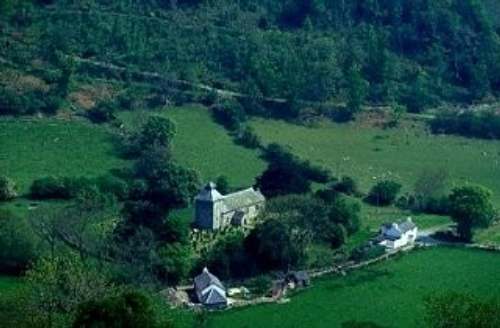Celtic landscapes have a way of stirring the human heart with their majesty and grandeur. They bring to mind the courageous and extremely self-sufficient saints who abandoned everything for a life of solitude and prayer in isolated, even treacherous, environs. These saints, by their holy and unconventional lives, conferred peace upon the land and the creatures because they had been liberated, at least in part, from their fallen human nature. As the Apostle Paul succinctly states:
 Church of Pennant Melangell |
Although the major life of St. Melangell was not written until the fifteenth century, it is likely that her cult flourished long before a life was written about her, so great was the esteem with which she was held by the local populace. The actual era and lineage of St. Melangell are disputed. However, even in the misty shadows of her Irish and/or Welsh genealogy, it is certain that she was of royal or noble lineage and, thus, was expected to marry. In response to God's call to a life of prayer and solitude, St. Melangell renounced her royal status for the religious life. Overlooking her boldness, her father insisted that she marry. Desiring above all things to be devoted to God alone, she fled Ireland around 590 and settled in Pennant, one of the most lonely and lovely areas of Montgomeryshire (present-day Powys), at the head of the Tanant Valley in Northern Wales. In this spot, which came to be called "Pennant Melangell", sleeping on bare rock with a cave as her cell, she lived a hidden life of prayer for almost fifteen years.
Around 604, St. Melangell was "discovered" by the Welsh Prince of Pengwern Powys, Brochfael Ysgithrog, while he was hunting in the area around Pennant2.  As his hounds pursued their prey, the frightened hare ran into a bramble thicket for safety. Searching for the hare in the thicket, the Prince unexpectedly found St. Melangell.
As his hounds pursued their prey, the frightened hare ran into a bramble thicket for safety. Searching for the hare in the thicket, the Prince unexpectedly found St. Melangell.  She was deep in prayer and had not heard the dogs or the horn or the sound of human footsteps. The breathless hare had hidden itself in the folds of her garment and peered out at the fierce hounds, trusting in its holy protectress. Prince Brochfael signaled the dogs to snatch the hare, but they dared not approach the saint nor would they kill the hare. Aware now of the situation, St. Melangell bravely drove the hounds back.
She was deep in prayer and had not heard the dogs or the horn or the sound of human footsteps. The breathless hare had hidden itself in the folds of her garment and peered out at the fierce hounds, trusting in its holy protectress. Prince Brochfael signaled the dogs to snatch the hare, but they dared not approach the saint nor would they kill the hare. Aware now of the situation, St. Melangell bravely drove the hounds back.
The Prince had never experienced anything like this before. He was utterly amazed and cautiously approached the anchoress for an explanation. After hearing her story, Prince Brochfael, deeply moved by St. Melangell's beauty, purity and love for God, had no choice but to acknowledge her sanctity. Nonetheless, he suggested that she leave her solitude and be wedded to him, but she adamantly refused. Impressed by her sanctity and determination, he donated a parcel of land, which included a churchyard and valley, to be used by her to found a monastery. The Prince expressed his fervent wish that the area be dedicated to the service of God. He also requested that the land be a place of refuge for people and animals, in particular the hares she had befriended long before the encounter with Prince Brochfael.
St. Melangell is reputed to have lived some thirty-seven years after the hunting incident. The area did indeed become a sanctuary under the anchoress' guardianship. During her life, no animal was ever killed on her land. A known haven of safety not just for hares, but for all creatures, even wild animals living in the area became tame.
 Shrine of St. Melangell |
The Church of Pennant Melangell is located near Llangynog in Powys. From its first foundation in the seventh century, it was a regular place of worship for the local farming community. For centuries no one would kill a hare in the church or vicinity of Pennant Melangell. Also, if anyone shouted at a hunted hare "God and Melangell be with thee", it was sure to escape. To this day, in honor of the saint, the hares are respected by the local hunters and are never harmed. After her death, St. Melangell became the tutelary saint of hares. Today, she is recognized as the Celtic patroness of animals and of the natural environment.
Through her resolve to maintain her spiritual focus at any cost, St. Melangell reached a life of "glorious liberty" in which she truly participated as a daughter of God. Local tradition holds that St. Melangell was specially called by the Lord Himself to restore the Pennant Valley to Paradise. Hence, her very presence imbued the land, creatures and people with joy, peace and security. Her community imitated and memorialized her life, bequeathing the essence of sanctity to the area forever.
 Church of Pennant Melangell at the head of the lush green Tenant Valley |
1. In Wales, St. Melangell's feastday is May 27th. The feastday used in England (which was also the ancient feastday) is January 31st.
2. It has been surmised that the nobleman to whom St. Melangell was betrothed was Brochfael Ysgithrog.